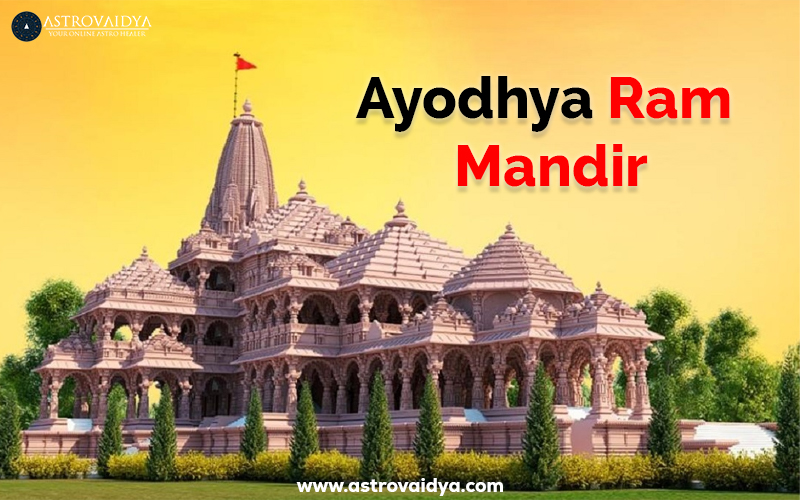
Ayodhya Ram Mandir
As the long-awaited finish of the Ayodhya Ram Mandir nears, it’s time to learn everything there is to know about our rich Hindu history through the wonderful structure that reflects not just a place of worship but a tribute to cultural pride. We discover the Ram Mandir’s history, architectural wonders, and deep importance.
The Architectural Appeal
- Outer Structure:
- Craftsmanship: Designed by architects Chandrakant Sompura, Nikhil Sompura, and Ashish Sompura.
- Grandeur: Spans three floors across 70 acres.
- Mandapas: Five mandapas named Kudu, Nritya, Rang, Kirtana, and Prarthana.
- Dimensions: 360 feet in length, 235 feet in width, and 161 feet in height.
- Gates: 12 gates with intricate columns.
- Foundation Stone: Laid on 5th August 2020, marking the initiation of the project.
- Shape and Style:
- Architectural Styles: Synthesis of Nagara, Vesara, and Dravida styles.
- Structure: Symmetry-shaped adhering to Vastu Shastra and Shilpa Shastra principles.
- Dome: Features a Dome.
- Pillars: 360 pillars, each standing at 16 feet, contributing to the majestic allure.
- Building Materials:
- Foundation: Rests on a robust foundation of two lakh bricks, each inscribed with “Jai Sri Ram.”
- Stones: Includes stones from the Banshi mountains in Rajasthan and pink stones from Mirzapur.
- Sandstone: Incorporates three lakh cubic feet of sandstone.
- Foundation Dimensions: 50 feet deep, 400 feet by 300 feet wide.
- Layers: Consists of 50 layers of building materials, each 10 inches thick.
- Interior Elegance
- Mandapa: The Nagara-style mandapa in the middle of Garbhagriha.
- Garbhagriha: A small room for deity placement.
- Shikhara: An octagonal-shaped Shikhara.
- Vahana: Lord Ram’s massive statue in a straight line.
- Idols: The central attraction is Lord Ram, along with the idol found in 1949.
- Bells: A 2100 kg bell, 6ft tall, and 5ft wide, costing 21 lakhs, adds a harmonious touch.
Significance Beyond Stones and Structures
The Ayodhya Ram Mandir transcends its physical existence. It symbolizes the culmination of a long-standing cultural and religious aspiration. The temple is a beacon of unity, inviting devotees to experience the divine and celebrate the shared heritage.
Beautiful Calm Paths
For those planning to start on a spiritual journey to Ayodhya, the Ram Mandir is centrally located, and easily accessible from various parts of the city. Whether you come seeking solace, architectural marvels, or a connection with history, the Ayodhya Ram Mandir promises an enriching experience.
FAQs
The Ayodhya Ram Mandir holds immense significance in Hinduism as it marks the birthplace of Lord Ram, a revered deity in the Hindu pantheon. The construction of the temple is not merely a physical endeavor but a symbolic journey, representing the culmination of a cultural and religious aspiration. Devotees believe that visiting the Ram Mandir brings spiritual blessings and a deep connection with the divine. The temple stands as a testament to faith, unity, and the rich cultural heritage of Hinduism.
The architecture of the Ayodhya Ram Mandir is a marvel that reflects the craftsmanship and cultural pride of the community. Crafted by architects Chandrakant Sompura, Nikhil Sompura, and Ashish Sompura, the temple’s outer grandeur and intricate details showcase precision and devotion. The synthesis of Nagara, Vesara, and Dravida styles, adherence to Vastu Shastra and Shilpa Shastra principles, and the use of stones from various regions are a homage to cultural traditions. The temple’s dimensions, pillars, and artistic elements are not just structural components but expressions of cultural identity and pride.
The construction of the Ayodhya Ram Mandir involved a symphony of stones and materials. The foundation, robust and enduring, rests on two lakh bricks, each inscribed with the sacred phrase “Jai Sri Ram.” Stones from the Banshi mountains in Rajasthan, pink stone from Mirzapur, and three lakh cubic feet of sandstone contribute to the temple’s magnificence. The meticulous selection of materials, including inscribed bricks, reflects the reverence and sanctity attached to the construction of this sacred edifice.
The idol found in 1949 within the Ayodhya Ram Mandir holds historical significance as it became a focal point in the Ram Janmabhoomi-Babri Masjid dispute. The discovery of the idol of Lord Ram in the central dome of the mosque triggered a series of legal battles and heightened tensions over the site. The subsequent legal proceedings and debates played a pivotal role in shaping the course of the Ayodhya Ram Mandir’s history, leading to the landmark decision in favor of the construction of the temple.
The Ayodhya Ram Mandir is centrally located, making it easily accessible from various parts of the city. Visitors can embark on a spiritual journey to Ayodhya to witness the architectural marvels, experience divine serenity, and connect with the historical and cultural roots of the temple. Whether seeking solace, marveling at the intricate details of the structure, or exploring the rich history, a visit to the Ayodhya Ram Mandir promises an enriching and spiritually uplifting experience for devotees and history enthusiasts alike.


















